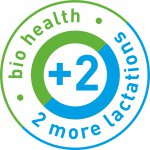Next day delivery
Order before 2:00PM
Free shipping
For orders above €100,-
Safe pay
By iDeal & Klarna
 |
A dairy cow lasts more than three lactations on average and has a lifetime production of approximately 26,000 kg of milk.
Extending the productive lifespan of dairy cows from three to five lactations provides many advantages. |
The bio health cow program helps to keep your animals healthy. Healthier animals are more productive and more profitable. Healthy livestock is also very important from the point of view of sustainable production and animal welfare!
From our practical experience and research, we know in detail what it takes to keep animals healthy and to let them perform optimally. The cow program gives you a better insight into the pain / bottlenecks (pain, discomfort, disappointing production results) on your farm and the relationship between them. This makes preventive intervention and adjustments to details easier. Timely identification is of great importance here. All this contributes to a healthier herd.
We think about every detail, becuse It’s about details!
What would it give you, as a dairy farmer, if your cows last five instead of three lactations? The financial benefit can reach tens of thousands of euros per year! If you keep your cows longer, you will save rearing costs and you can produce more milk within your current phosphate reference.
This provides the following benefits, among others:
A Dutch dairy cow lasts more than three lactations on average and has a lifetime production of approximately 26,000 kg of milk. Extending the productive lifespan of dairy cows from three to five lactations provides the following benefits for a farm with 100 dairy cows…
The nutrition of the young calf plays a major role in achieving a calving age of 23 months. This starts with good quality colostrum, but nutrition is also important in the follow-up phase. In addition, hygiene and housing for the dairy cattle plays an important role.
From weaning to calving, the health of the calves and heifers is central. Nutrition plays an important role in this and vitamins and minerals are very important within the diet.
Just before and when a heifer or a calf cow comes into lactation, all kinds of changes take place. Often these bring a lot of stress to the cow. For example, calving causes stress, but also ration changes and moving the animals entails stress. Because milk production starts, a lot is asked of the cow, which also triggers all kinds of metabolic processes. This is the moment when the cow often needs extra support in order to perform optimally.
There are several aspects that require time and attention for a trouble-free and optimal lactation. For example, claw health must be in order, which is often (largely) partly related to food. Good fertility is also important to ensure that the cow is put on time and in preparation for the next lactation. Furthermore, udder health plays an important role in increasing the cow’s lifespan and life production during lactation and also during the dry period. Attention must be paid to details in order to achieve optimal results.